About Creeping Junipers - Tips For Growing Creeping Juniper Ground Cover
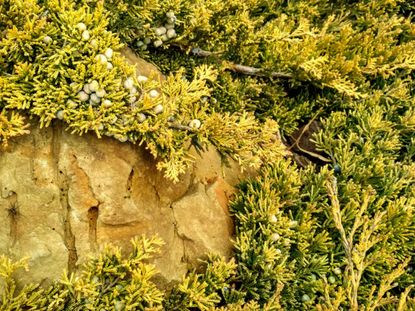

If you're looking for a low-growing ground cover that thrives on neglect, give creeping juniper (Juniperus horizontalis) a try. These graceful, aromatic shrubs spread to fill sunny areas and they can be used as foundation plants or accents in flower borders. Use them near decks, porches, and garden seating where you can enjoy their pleasant fragrance. Learn more about creeping juniper care and how to use creeping juniper ground cover in your landscape.
About Creeping Junipers
Creeping juniper is a low-growing, evergreen shrub that is often used as a ground cover. It features plume-like branches that extend horizontally. The foliage often has a blue-green cast in spring and summer and plum-colored tint in winter. Male and female flowers grow on separate plants, and the female plants produce berries. Neither the flowers nor the berries are particularly ornamental.
The height varies depending on the cultivar. They may be as short as 6 to 8 inches (15 to 20.5 cm.) or as tall as two feet (61 cm.). Each plant can spread as much 6 to 8 feet (2 to 2.5 m.). Creeping juniper ground cover is ideal for xeriscaping. Growing creeping junipers on slopes and hillsides helps prevent soil erosion as well.
Creeping Juniper Requirements
Creeping juniper adapts to almost any soil, including those that are hot, dry, and poor in fertility. In fact, these little shrubs flourish in hot, dry conditions near walls and sidewalks where most ornamentals won't survive.
You can also take advantage of their drought-resistance by planting them in areas where irrigation isn't always possible. While it thrives in clay, compacted, and sandy soils where grass refuses to grow, the shrubs prefer well-drained soil and a sunny location.
Creeping Juniper Care
As with most juniper shrub care, creeping juniper is a low-maintenance plant that never needs pruning or cutting back. In fact, creeping junipers won't tolerate a lot of pruning. However, you can remove some of the plants if it spreads beyond its boundaries, though it may be easier to select a species or cultivar that naturally grows to a height and spread to fit the site you have in mind.
Watch for insects and diseases. Control bagworms and webworms by removing and destroying the bags and webs. Control scale insects, spider mites, leaf miners, and aphids with insecticides labeled for the target insect.
Gardening tips, videos, info and more delivered right to your inbox!
Sign up for the Gardening Know How newsletter today and receive a free download of our most popular eBook "How to Grow Delicious Tomatoes."
Creeping juniper is susceptible to several fungal diseases that cause yellowing, browning, and dieback. Cut off infected parts of the plant and use a fungicide labeled for use on junipers.

Jackie Carroll has written over 500 articles for Gardening Know How on a wide range of topics.
-
 Urban Composting Guide: How To Compost In The Middle Of The City
Urban Composting Guide: How To Compost In The Middle Of The CityUrban composting does not have to be daunting. You can compost in the city, and maybe even try some urban worm composting!
By Mary Ellen Ellis
-
 Shrub Diseases And Pests To Watch Out For
Shrub Diseases And Pests To Watch Out ForShrub diseases and pests can be challenging. Learn how to recognize and eradicate them before they can present a danger to your plants.
By Susan Albert
-
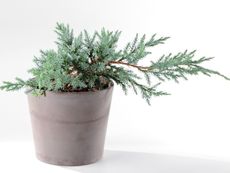 How To Grow A Potted Juniper: Caring For Juniper Trees In Containers
How To Grow A Potted Juniper: Caring For Juniper Trees In ContainersSmall juniper trees grow well in containers. Click here for information on how to care for potted junipers.
By Teo Spengler
-
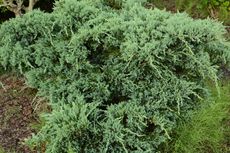 Japanese Juniper Care – How To Grow A Japanese Juniper Plant
Japanese Juniper Care – How To Grow A Japanese Juniper PlantIf you want a "set and forget" type of plant, Japanese juniper care is minimal and easy once established. For more information about this shrub of low heights and how to grow it in your garden, click the following article.
By Bonnie L. Grant
-
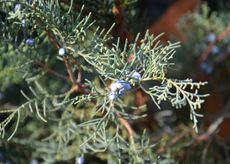 Mountain Cedar Information: Is Mountain Cedar Pollen Causing You Problems
Mountain Cedar Information: Is Mountain Cedar Pollen Causing You ProblemsMountain cedar is a tree with a common name full of contradictions. The tree is not a cedar at all, and its native range is central Texas, not known for its mountains. In fact, trees called mountain cedar are actually ashe juniper trees. Click here to learn more.
By Teo Spengler
-
 Are All Juniper Berries Edible – Is It Safe To Eat Juniper Berries
Are All Juniper Berries Edible – Is It Safe To Eat Juniper BerriesJuniper berries have been used as a strong flavoring for wine, mead, and other alcoholic beverages, as well as a spice for meats, stews, sauerkraut, and other dishes. Upon reading this, you may be wondering are all juniper berries edible? Click here for that answer.
By Darcy Larum
-
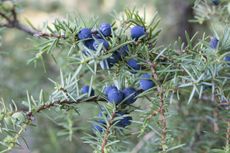 Juniper Berry Uses – What To Do With Juniper Berries
Juniper Berry Uses – What To Do With Juniper BerriesGiven that they are prolific and the fruit looks so much like a berry, the natural question is ‘can you eat juniper berries?” If so, what do you do with juniper berries? Click on the following article to find out how to use juniper berries along with some useful juniper berry recipes.
By Amy Grant
-
 Juniper Berry Harvest Tips: How To Pick Juniper Berries
Juniper Berry Harvest Tips: How To Pick Juniper BerriesThere are about 40 species of juniper, most of which produce toxic berries. But for the educated eye, Juniperus communis, has edible, pleasantly pungent berries. Click this article for tips on how to pick juniper berries and how to recognize safe juniper plants.
By Bonnie L. Grant
-
 Growing Juniper ‘Blue Star’ – Learn About Blue Star Juniper Plants
Growing Juniper ‘Blue Star’ – Learn About Blue Star Juniper PlantsWith a name like "Blue Star," this juniper sounds as American as apple pie but, in fact, it is native to Afghanistan, the Himalayas, and western China. Gardeners love Blue Star for its thick, starry, blue-green foliage and its graceful rounded habit. Learn more here.
By Teo Spengler
-
 Can You Prune An Overgrown Juniper – Tips For Overgrown Juniper Pruning
Can You Prune An Overgrown Juniper – Tips For Overgrown Juniper PruningJuniper shrubs and trees are a great asset to landscaping. But sometimes, like the best things in life, they get away from us. What was once a smart shrub is now a wild, overgrown monster. So what can you do with a juniper that?s gotten out of hand? Find out here.
By Liz Baessler